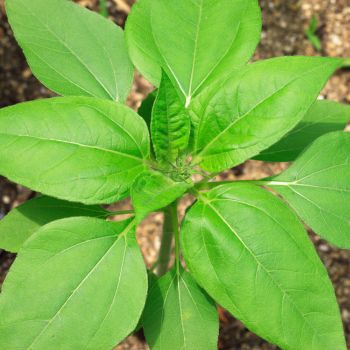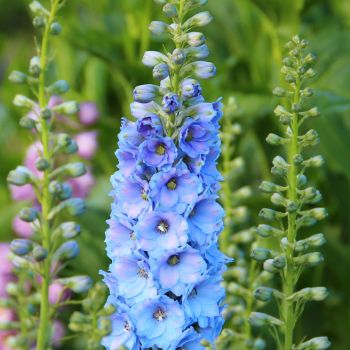A field full of nodding sunflowers is a stunning sight in the height of summer. But while sunflowers are a valuable commercial crop thanks to the seeds' high oil content, they're also ideal for growing on a smaller scale at home.
They're so easy to grow that they often appear uninvited below a well-stocked bird feeder, but to get the best results a little more gardening input is required. Here's what you need to know.
Sunflower Botany and History
The sunflower is known botanically as Helianthus, and in its original form it's a herbaceous perennial native to Mexico, California, and surrounding areas. There's evidence that it's been cultivated since at least 3,000BC.
In its modern form it's most often grown as an annual, with suitable varieties containing Helianthus annuus in their botanical name.
The common sunflower name comes partly from the large, round, blazing-yellow flower that's so instantly recognisable. However, it also refers to the plant's curious growing habit. When young, the growing head turns toward the sun, tracking it across the sky to maximise the sunlight it receives. Once the buds open this behaviour will stop, and the head will be fixed pointing in a roughly northerly direction.
Appearance and Growth
The sunflower is one of the fastest-growing plants around, reaching its full height of up to 3.5m in a single growing season. However, if your garden doesn't have space for these monsters, smaller varieties are available reaching from 1m upward.
Sunflowers can grow on a single stem or multiple branches, depending on both the variety chosen and the cultivation methods. For most people, the main reason for growing the plant is the distinctive flower, with a whirl of bright petals surrounding a dark seed head containing an average 1,200 seeds.
On the larger varieties, the flower heads can be up to 50cm across. The bright yellow flower is typical, but varieties are available with orange, red, or even striped petals
Nutritional Value and Cooking
Pound for pound, sunflower seeds hold almost the same amount of protein as beef, with twice the iron and four times the phosphorous content. This makes sunflower seeds a prized ingredient for vegetarian and vegan diets.
The seeds are also rich in vitamins B and E, with some vitamin A, and, depending on how near the seeds are to sprouting, a healthy amount of vitamin C.
The seeds can be cold-pressed into oil, with the homemade variety being far nuttier and stronger tasting than store-bought examples, making a great ingredient for robust salad dressings.
Sunflower seeds can be eaten raw, but are best enjoyed after roasting at 200°C or dry-frying until lightly golden. Once shelled, the seeds can be scattered into salads, ground into a peanut butter replacement, used in bread or other baking, or added to any recipe which calls for nuts.
How to Grow Sunflowers
Sunflowers should be grown in full sun, requiring around 5-7 hours a day to thrive. They need a well-drained soil that has good texture to a depth of at least half a metre, to accommodate the large root system which anchors the plants in place.
Seeds can be sown outdoors when there's no risk of frost, any time from late winter to late spring depending on the local climate. While sunflowers aren't classed as fully hardy, the seedlings can handle a short spell of cold but require a relatively warm soil at 14°C to germinate reliably.
If your local growing season is long enough, seeds can be sown successionally every two to three weeks for a longer floral display and multiple harvests.
Sow seeds about 2cm deep, spacing a minimum of 30cm each way for smaller varieties, or up to 100cm each way for the tallest ones. Sunflowers will still grow with closer spacing, but will produce progressively smaller flowers.
Smaller varieties can be grown in large pots of at least 50cm across, or 15-25cm for dwarf varieties.
After sowing, applying an organic mulch will help to maintain soil temperature, keep birds away from the seeds, and reduce weed competition. Keep the soil moist but not waterlogged until germination, then water daily after that. Watering needs to be plentiful and consistent for such fast-growing plants, but avoid watering in the evenings as overnight dampness encourages fungal diseases.
Once the seedlings are around 15cm high, feed with a tomato feed or a general-purpose fertiliser, but avoid nitrogen-rich products which will delay flowering.
To ensure a single flower head, remove side shoots as they form. However, this will lead to a weaker plant more likely to need support. If you prefer multiple smaller heads on a bushier plant, leave the side shoots in place but start pinching out the growing tips once enough buds have appeared for your preference
Harvesting Sunflowers
To prolong flowering, cut off the whole flowers as soon as they start to fade. However, for a seed harvest the dead flowers should be left on the stem until the seeds form and become easy to dislodge. A good sign that the seeds are ready is when birds start to feed on them in earnest.
On average, the seeds will be ready to harvest around 10-12 weeks after germination for smaller varieties, or 12-16 weeks for larger ones.
To harvest cut the entire seed head away, leaving some of the stalk attached. Hang it upside down in a cool, dry, airy place until the seeds are loosened. At this point, hold the head over a bucket and bang it hard against the side. Any seeds which don't fall out immediately can be scraped out with a fork.
Sunflowers as Green Manure
Grown with a little less care and pampering, sunflowers can also make a good 'green manure' crop, protecting and nourishing the soil after the year's main annual plants have been cleared.
For the best and most economical results, liberally scatter ageing or pet-grade sunflower seeds over the area and rake over. Water as needed until the seedlings germinate. Cut them back once they reach 30cm in height, leave them to wilt for a day or two, and dig the debris into the soil where they will rot down in place.
After a month or so, the beds will be ready for your next sowing, with soil nutrients replenished and most weeds kept at bay.
Common Sunflower Problems
Given the right conditions of full sun, good soil, and plenty of water, sunflowers are a relatively straightforward plant to grow. However, there are a few common problems you may encounter.
- As their flower heads turn toward the sun, if you site the sunflowers carelessly you may find you're met with a row of plants with their faces hidden from view. For harvesting seeds this isn't a problem, but it may be an aesthetic or garden design issue.
- Birds have a strong liking for the seeds as they ripen, so consider covering the seed heads with a paper bag, or net the whole sunflower patch to provide protection.
- Hot, wet, and humid conditions, or damp foliage overnight, can risk several fungal diseases such as mildew and downy rust. To reduce the risks, space the plants correctly to provide good air flow, keep weeds in check, and water carefully in the mornings with as little splashing as possible.
- Sunflower moths can lay eggs in the seed heads. As the resulting caterpillars feed, they not only reduce the harvest but can infect the plants with disease. Regularly check the flowers for larvae and remove immediately.
- The taller varieties will definitely appreciate support with a sturdy garden cane, while in more exposed areas anything but the dwarf bushy varieties should also be supported.
- Slugs and snails can be a major problem at the tender seedling stage; less so as the plants grow larger.
Sunflowers are worth growing just for their beauty alone. But add in the nutritional and taste benefits of the seeds - for both birds and humans - and it's a flower to be valued wherever growing conditions allow.











